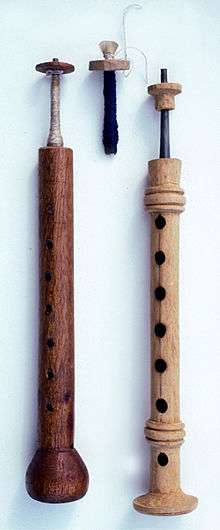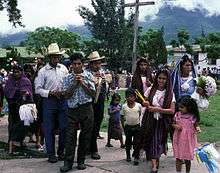Chirimia
Chirimía (sometimes chirisuya in Peru[1]) is a Spanish term for a type of woodwind instrument similar to an oboe. The chirimía is a member of the shawm family of double-reed instruments, introduced to Central and South America in the sixteenth and seventeenth centuries by the Spanish clergy.[2]

Distribution
Usage of the chirimía varies widely across Latin America and Iberia, with the instrument being extinct in some areas, but a living tradition in others.
The chirimía and drum are used to accompany religious processions and annual commemorative dance-dramas in many remote areas of Latin America, including Jacaltenango, Guatemala. The music produced is quite unique and varies from one region to another. This tradition is an adaptation of the pre-Columbian practice of accompanying religious ceremonies and processions with drums, flutes, and whistles.
There are two types of chirimías in Guatemala, a small one and a large one. The size of the holes and their location determine the sound of the small or large chirimías. In some parts of Latin America, as in Jacaltenango, small and large chirimías are played together with small and large drums.
The regular chirimía has 10 holes, while the Guatemalan and Mexican chirimía has 6 to 10 holes. Although the outward appearance of the chirimías and the number and size of holes vary regionally throughout Mexico and Guatemala, these chirimías are all double-reeded wooden instruments. Some of the chirimías have a conical bore, while others have a cylindrical bore. The types of reeds and manner in which they are kept in place also vary.
The Jakaltek chirimía, called su’ in the Jakaltek language, is very similar to the chirimías of central and southern Mexico.[3] The Jakaltek chirimía is 34.5 cm long, without the double-reed in place. The wooden part is 27 centimeters long and has a cylindrical bore, with 6 vertical holes, and 2 lateral holes. The mouthpiece consists of a staple, a tapered metal cylinder, that is wrapped with string and topped with a wooden pirouette. The bulbous bottom portion of the staple fits snugly into the wooden portion of the instrument, but can be easily removed for cleaning.[4]

Extinct
- Nuevo Leon and Tamaulipas: disappeared by the mid-19th century.[5]
References
- Dale Alan Olsen; Daniel Edward Sheehy (2008). The Garland handbook of Latin American music. Psychology Press. pp. 47–. ISBN 978-0-415-96101-1. Retrieved 9 May 2011.
- Charles McNett. The Chirimia: a Latin American Shawm. Galpin Society. 1960.
- J. Eduardo Sánchez. Formación Estética, Guatemala: Educación Musical, 1969; Joan Rimmer. “The Instruments Called Chirimía in Latin America”, 1976.
- Carol Ventura. "La Chirimía de los mayas-jakaltekos de Guatemala", in Tradiciones de Guatemala, Ethnomusicología en Guatemala, Universidad de San Carlos, Guatemala, 2006: 63-73.
- Cathy Ragland (28 May 2009). Música norteña: Mexican migrants creating a nation between nations. Temple University Press. pp. 46–. ISBN 978-1-59213-747-3. Retrieved 9 May 2011.
Further reading
- International Double Reed Society (2008). The double reed. International Double Reed Society. Retrieved 9 May 2011.
External links
- Video - Mexican chirimía oboe at YouTube
| Wikimedia Commons has media related to Chirimía. |